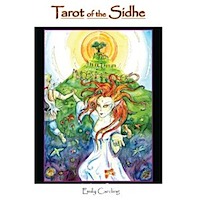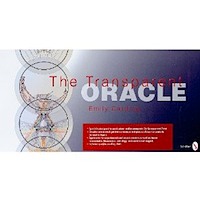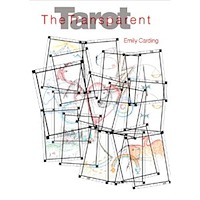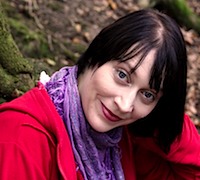By Terri C.
Emily Carding is a self taught artist, author, as well as a Priestess, lyricist, singer, actor, wife and mother. She is quickly becoming well known for her work in the Tarot community as creator of The Transparent Tarot, The Transparent Oracle and the upcoming Tarot of the Sidhe.
Tarot Reflections: Besides your involvement in the Tarot community, what other interests do you have that you would like to share with our readers?
Emily Carding: I could probably best describe Tarot and divination as being my specialization within the wider world of magick and the mysteries. My other main areas of interest in this area are mythology and folklore, Faery Tradition, Wicca and the ancient Gods and Goddesses. Hekate is commanding much attention at the moment and my feeling is that this will be the case for a long time to come! She was certainly a source of unconscious inspiration for the Transparent Oracle. My training was actually in Theatre, which serves me well in my magickal work as of course the two share common roots. I also love to sing and perform in a band with my husband!
TR: What brought you to the world of divination? What tools have you used in the past for divination?
EC: I have a long-abiding fascination for the cards, which I can trace back to my childhood. My mother was interested in such things when she was a teenager and though when I was growing up it wasn’t really spoken about, there were these two books that I used to sneak forbidden peeks at. One was the Secret Lore of Magick by Idries Shah, and the other was The Devil’s Picturebook by Paul Huson- a classic work on the Tarot’s major arcana. When I was old enough, my mum gave me her old and battered Rider-Waite, but I never really got on with it- I tried! In fact there was something odd about that specific pack. For all those years it would only give negative readings and no-one could clear it. Eventually, I decided to burn it in my cauldron as part of a ritual. Interestingly, not long after that I started to create my first deck, and my mum started to rediscover her interest in the cards after many years of blocking that part of her life. It was as though the act of burning those cards released a blockage!
When I first consciously started to practice magick, Tarot was something that as a visually oriented person I was naturally drawn to. My first pack other than the ill-fated Rider-Waite was John and Caitlin Matthews’ Arthurian, which I was able to read so successfully on a purely intuitive basis that I really didn’t study traditional Tarot properly for years after that. Another interesting sign in those early days is that one of the first gifts given to me by my early mentors was a blank set of Tarot- I think they knew!
TR: How has reading cards are using tools of divination affected you personally?
EC: I’m not someone who consults the cards on every little thing, but they are an indispensible tool. Having cards you can rely on is like having a spy on the inside of the organization of Life. Certainly there are paths I have not taken due to the advice that has come through in readings. I have really learned to trust the input they bring. I also think that using…and of course creating your own Tarot opens you up to universal symbolism and the unfolding pattern of the world around us.
TR: What drew you to Tarot and Oracle decks as a medium for your art?
EC: It brings together my love of magick and art in such a tangible way. I love to create not simply for art’s own sake, though that is a joy of course, but as a gateway…as a tool for others to use, to help them on their path. I also find that through creating in this way, I am doing a service to those otherworldly beings who wish to be give voice in this world, if that makes sense.
TR: What do you like best about tarot/oracles? What do you find most amazing?
EC: Symbolism is the voice of the soul. There are so many decks now that most people should be able to find a set of symbols that really works for them, and that is wonderful. I am always fascinated to see other people’s interpretations of the Universal archetypes of the Tarot. Sometimes I am disappointed, when only a superficial understanding is displayed. Sometimes I am amazed! There is always something more to learn.
TR: Out of the three decks that you have created, what is your personal favorite? Why?
EC: Oh my, what a question! That is like choosing between children! The Transparent Tarot is a child of my mind- most particularly the mercurial, inventive aspect of my mind. The Transparent Oracle I think bridges my mind with my soul. In that I tried to put my accumulated esoteric insight and wisdom so far, and there was definitely something working through me to that end. So it is also a child of my mind, but perhaps a different part of it, and certainly a child of my soul. The Tarot of the Sidhe is a child of my heart, so of all of them, this is the one I am most emotionally and spiritually connected to, the one that is most important to me as part of my life’s role. That may sound odd, as it is not as clever, revolutionary or inventive as the transparent decks, so it is unlikely to make such an impact on the Tarot world, but it is the truth.
TR: Would you tell us a little bit about the process that you went through in creating the Transparent Oracle? Including the medium used, where the idea of transparent cards and layering came from…
EC: The transparent idea was a bolt of pure inspiration. It was quite literally a ‘eureka’ moment which woke me up at around three in the morning! Then I presumed that either it had already been done or simply couldn’t be done on a practical level, but once I realized that it hadn’t been done, I started to see how it could be done effectively and initially drew designs onto tracing paper to make sure that cards would combine in particular ways to create new impressions. There were then drawn out in more detail using fibre-tip pens and lots of tiny dots on regular paper. These I then scanned into my computer to be printed on acetate. Having them on the computer also meant I could play around with different combinations easily and make sure they worked. The idea behind the dots was that the images would blend better together without clashing solid lines. So this was the techniques for creating the Transparent Tarot, and I used pretty much the same method for the oracle, except it utilized a lot more geometry. I created a template with various widths of circles and a hexagram which I referred to while creating each card. This enabled me to give locational significance to the creatures and symbols in the cards, as well as make sure they all related to each other in the right way.
TR: Why did you choose to go with round cards, for this particular deck?
EC: The first impulse was to take the transparent idea even further by adding this extra dimension of flexibility. I tried my best to take full advantage of this circular shape by actually designing the cards in such a way that they could be rotated to bring even greater fluidity to their usage. There aren’t many circular decks, and those that I am familiar with aren’t really designed to be viewed from all angles, they are simply pictures printed on circular cards. I thought it would be an effective idea to have these transparent cards that would create unique mandala-like images when you overlay them. This makes them very effective for creating gateways that are tailored to the individual’s needs at that time.
TR: What is your favorite card in the Transparent Oracle deck? And, why?
EC: I think I would have to say the Owl card, for several reasons. Owl is a very significant animal for me personally, in my work. It is one of the first cards that I completed for the Transparent Oracle, and I find it exciting how it forms a shaman-like mask over the face of many of the other cards. It’s also one of the cards which demonstrates how I gave myself more aesthetic freedom in the artwork in comparison to the purposefully very minimalist Transparent Tarot.
TR: What's your number one tip for better tarot/oracle readings, in general?
EC: I’ve found that wearing a large Pirate hat helps! Seriously, different things work for different people. Whatever helps you to relax, to get into the right mindset. And keep your feet on the ground! Being grounded is something I find so important.
TR: Are there any tips you would like to offer our readers, for using the Transparent Oracle?
EC: I would say don’t try too hard. If you’re familiar with the work of Philip Pullman, using the Transparent Oracle is a bit like using the alethiometer! It works best when you relax and let messages and symbols surface, even – or especially- if they seem strange or unexpected! The people who have been using the deck most effectively find that often what they perceive doesn’t seem on the surface to instantly relate to the cards, but that the different combinations of cards unlock certain gateways. It does seem to be a deck that needs some dedication and patience, but it does reward you for your efforts.
TR: This deck can be used for many things outside of divination, what is your favorite task for your Transparent Oracle?
EC: In a workshop setting, I enjoy using it for group magick, to create an image from cards selected by members of the group to represent their gifts for change within the world. On a personal level I enjoy asking it questions about the nature of things- I get some interesting answers! It always adds to my understanding in unexpected ways.
TR: What is it like to give readings with a deck that is 100% your own creation? Has anyone given you a reading with the deck yet?
EC: The decks I have created so far are like an extension of my own senses, like bringing the hidden parts of my understanding out into the open. It’s a special bond, I feel very blessed. Of course I now have over a hundred other decks that mostly just sit around, but I will sometimes bring out someone else’s work because I know it will bring me a fresh angle.
I find it fascinating to be read for by others with my decks, because it’s clear that they have made it their own. Others have taught me so much about what is in there that I am often previously unaware of!
TR: What project(s) are you working on now (that you can talk about), that we can expect to see from you in the future?
EC: Well coming up over the next few months are some very exciting things! I am currently working on the booklet for Tarot of the Black Mountain, which is a majors only deck that I created that originally had a very limited release in Montenegro in South-Eastern Europe. I am pleased to announce that the deck will be made available soon in a luscious edition from Tarot Media Company!
I’m also very excited that the book and deck set of the complete Tarot of the Sidhe will be available in the early months of next year from Schiffer Books, who also published Transparent Tarot and Transparent Oracle.
In terms of what else I am currently working on, there’s a lot of non-Tarot work in the pipeline. A book called God of the Vikings by Marion Pearce for which I created the illustrations is coming out in November 2010 from Avalonia Books, so that will appeal to anyone with an interest in Norse lifestyle and mythology.
The BIG project that I am just starting is a book called Faery Craft for Llewellyn, which will be all about embracing Faery as part of a complete lifestyle, including practical exercises and lots of information about working with Faery, photos from the faery festivals and interviews with key influential people. It promises to not only be profound and useful as a gateway for people into that world, but also lots of fun!
And for those wondering what’s next from my Tarot brain, I am still quietly finding time to work on the Neverland Tarot, a deck for the child that will never grow up who lives in all of our hearts…




